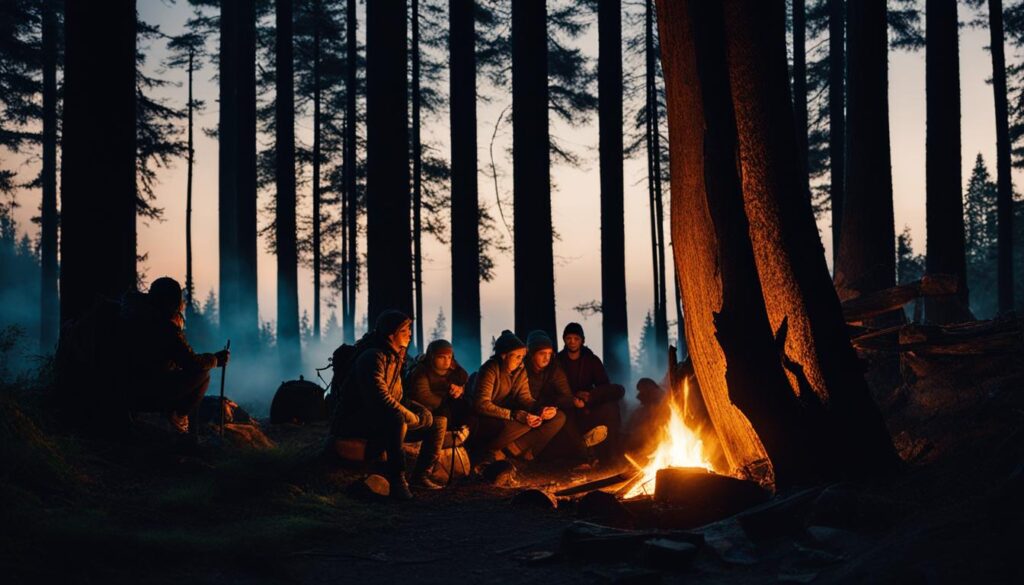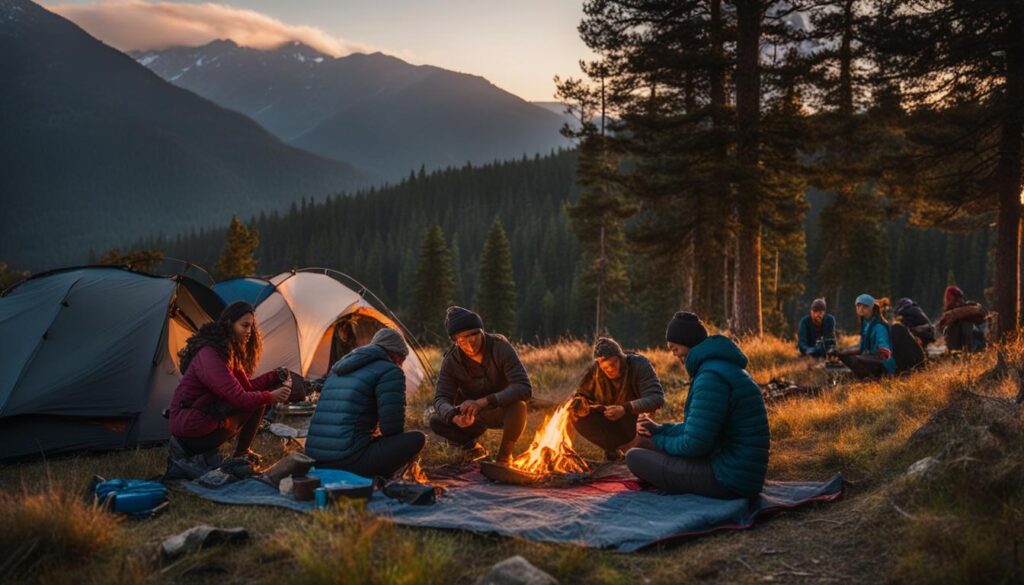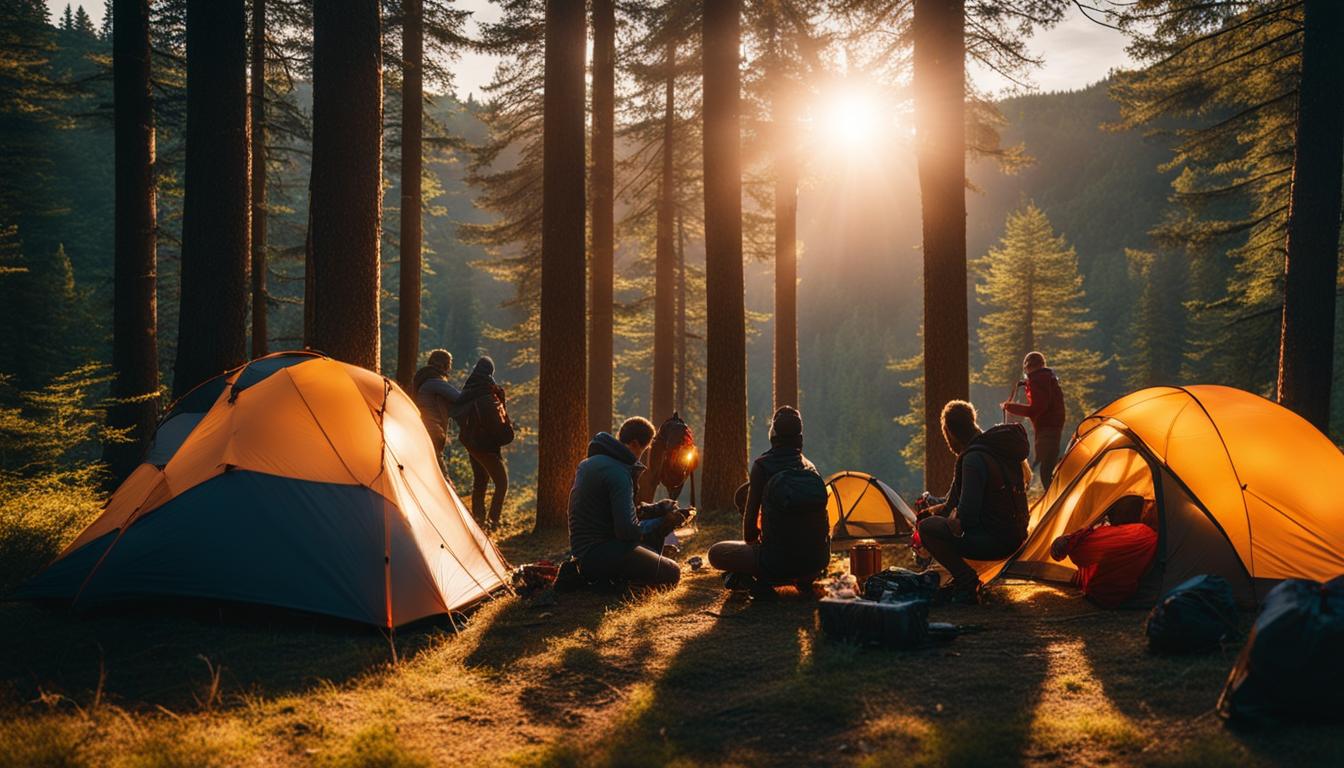Hey there! Are you ready to embark on a thrilling backpacking adventure? Setting up a campsite efficiently is key to ensuring a smooth and enjoyable trip. In this article, I will share some effective techniques and tips to help you streamline the backpacking camp setup process. From organizing your gear to maximizing downtime in camp, these strategies will optimize your backpacking experience. So, let’s dive in!
Key Takeaways:
- Efficient camp setup routines are essential for a successful backpacking trip.
- Developing a consistent nighttime and morning camp routine helps save time and stay organized.
- Key steps in the nighttime routine include hanging the bear bag, setting up shelter, and organizing gear.
- The morning routine focuses on efficiently breaking down the campsite and preparing for the day.
- By streamlining camp routines, you can maximize downtime in camp and optimize your backpacking experience.
Nighttime Camp Routine

When it comes to setting up a backpacking camp efficiently, having a well-organized nighttime routine is essential. By following a consistent process, you can save time and streamline your camp setup, allowing for more relaxation and enjoyment during your outdoor adventures.
The nighttime camp routine starts with hanging the bear bag to protect your food from wildlife. This important step ensures that you can have a peaceful night’s sleep without any unwanted visitors. Next, getting water is crucial for cooking meals and staying hydrated throughout the night. Remember to choose a water source that is safe and reliable.
After securing your food and water, it’s time to set up your shelter and sleeping systems. Whether you prefer a tent or a hammock, make sure to select a suitable location and properly assemble your shelter. Inflating your sleeping pad and lofting your sleeping bag will ensure a comfortable and restful night’s sleep.
Once your shelter is set up, take the time to organize your gear. Unpack your essentials and keep what you will need for the evening easily accessible. Store the rest of your gear in a waterproof pack liner to keep it dry and protected. This will make it easier to find what you need the next day.
With your gear organized, it’s time to prepare dinner. Cook a delicious meal, taking care to clean up afterward and wash your cooking utensils. Completing these tasks will help maintain a hygienic campsite and prevent unwanted smells or attract wildlife.
Finally, before settling in for the night, remember to pack your bear bag with any leftover food and smellables and hang it out of reach of wildlife. This step is crucial for both your safety and the preservation of the natural environment. With your nighttime camp routine complete, you can rest easy and prepare for a new day of backpacking adventures.
Morning Camp Routine

As the sun rises and a new day begins, it’s time to start the morning camp routine. This routine is all about efficiently breaking down the campsite, packing gear, and preparing for the day ahead. By following these steps, you can ensure a quick departure and leave behind an organized campsite.
Gear Packing
Efficiently packing your gear is essential to a smooth morning routine. Start by rolling up your sleeping bag and deflating your sleeping pad. Pack them away in their designated compartments or stuff sacks. Next, gather your clothing, food bag, and any other loose items. Stash them in your backpack or pack them in waterproof bags for easy access.
Don’t forget to pack your shelter, whether it’s a tent or hammock, and any external pockets or accessories. Keeping everything compact and secure will make it easier to carry and prevent items from shifting during your hike.
Campsite Cleanup
Before leaving, it’s important to leave your campsite as you found it, if not better. Collect any trash or food scraps and dispose of them properly in designated containers. Inspect the area for any signs of your presence, such as footprints or disturbed vegetation, and do your best to minimize them.
Double-check that the fire pit is fully extinguished and cold to the touch. If using a camp stove, make sure it is turned off and safely stored. Leave no trace by following proper outdoor ethics and leaving nature untouched for future visitors to enjoy.
Ready for the Day
With your gear packed and the campsite clean, take one last look around to ensure you haven’t left anything behind. Strap on your backpack and take a moment to appreciate the beauty of your surroundings. Now, you’re ready to hit the trail and embark on your next adventure!
| Step | Description |
|---|---|
| 1 | Pack sleeping bag and pad |
| 2 | Gather clothing and food bag |
| 3 | Pack shelter and external pockets |
| 4 | Clean up campsite |
| 5 | Inspect for traces of presence |
| 6 | Ensure fire pit and stove are off |
| 7 | Double-check for forgotten items |
| 8 | Begin the next adventure! |
Conclusion
After exploring efficient ways to set up a backpacking camp, it becomes evident that establishing a consistent camp routine is crucial for a successful trip. By streamlining camp routines, we can save time and stay organized, ultimately maximizing our enjoyment of downtime in camp.
Throughout the article, we discussed the importance of an organized campsite and how it contributes to an optimized backpacking experience. By developing a nighttime camp routine, we can efficiently set up our shelter, organize gear, and ensure a smooth transition into the evening. Similarly, a morning camp routine allows for a quick and organized breakdown, setting us up for a seamless departure.
By following these efficient backpacking camp setup techniques, we can make the most of our time in the great outdoors. Whether it’s hanging the bear bag, setting up a shelter, inflating sleeping pads, or organizing gear, every step contributes to a well-structured camp routine. This not only saves time but also allows us to fully immerse ourselves in the beauty of nature, optimizing our backpacking experience.

